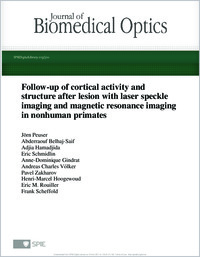Follow-up of cortical activity and structure after lesion with laser speckle imaging and magnetic resonance imaging in nonhuman primates
- Peuser, Jörn University of Fribourg, Department of Physics, Switzerland
- Belhaj-Saïf, Abderraouf University of Fribourg, Department of Medicine, Program in Neurosciences, Switzerland
- Hamadjida, Adjia University of Fribourg, Department of Medicine, Program in Neurosciences, Switzerland
- Schmidlin, Eric University of Fribourg, Department of Medicine, Program in Neurosciences, Switzerland
- Gindrat, Anne-Dominique University of Fribourg, Department of Medicine, Program in Neurosciences, Switzerland
- Völker, Andreas Charles University of Fribourg, Department of Physics, Switzerland
- Zakharov, Pavel University of Fribourg, Department of Physics, Switzerland
- Hoogewoud, Henri-Marcel HFR Hôpital cantonal Fribourg, Department of Radiology, Switzerland
- Rouiller, Eric M. University of Fribourg, Department of Medicine, Program in Neurosciences, Switzerland
- Scheffold, Frank University of Fribourg, Department of Physics, Switzerland
-
02.09.2011
Published in:
- Journal of Biomedical Optics. - 2011, vol. 16, no. 09, p. 096011
English
The nonhuman primate model is suitable to study mechanisms of functional recovery following lesion of the cerebral cortex (motor cortex), on which therapeutic strategies can be tested. To interpret behavioral data (time course and extent of functional recovery), it is crucial to monitor the properties of the experimental cortical lesion, induced by infusion of the excitotoxin ibotenic acid. In two adult macaque monkeys, ibotenic acid infusions produced a restricted, permanent lesion of the motor cortex. In one monkey, the lesion was monitored over 3.5 weeks, combining laser speckle imaging (LSI) as metabolic readout (cerebral blood flow) and anatomical assessment with magnetic resonance imaging (T2-weighted MRI). The cerebral blood flow, measured online during subsequent injections of the ibotenic acid in the motor cortex, exhibited a dramatic increase, still present after one week, in parallel to a MRI hypersignal. After 3.5 weeks, the cerebral blood flow was strongly reduced (below reference level) and the hypersignal disappeared from the MRI scan, although the lesion was permanent as histologically assessed post-mortem. The MRI data were similar in the second monkey. Our experiments suggest that LSI and MRI, although they reflect different features, vary in parallel during a few weeks following an excitotoxic cortical lesion.
- Faculty
- Faculté des sciences et de médecine
- Department
- Département de Médecine, Département de Physique
- Language
-
- English
- Classification
- Physics
- License
- License undefined
- Identifiers
-
- RERO DOC 28314
- DOI 10.1117/1.3625287
- Persistent URL
- https://folia.unifr.ch/unifr/documents/302136
Statistics
Document views: 58
File downloads:
- sch_fca.pdf: 132
